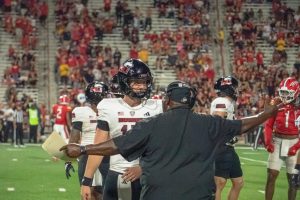Women take lead in college
October 22, 2002
Male college students may not have noticed, but for the last two decades they are statistically the minority among colleges and universities.
Since 1979, women’s enrollment at four-year colleges has surpassed men’s. This gender gap is evident in the number of bachelor’s degrees awarded as well. The U.S. Department of Education Web site estimates the number of degrees received by women to be at 698,000, while degrees awarded to men are estimated at 529,000.
Male students at NIU adhere to this national trend.
Of 24,948 students, 53 percent are female. This 6 percent gender difference has been relatively consistent since 1984, a few years after the national trend was sparked. Fifty-four percent of NIU’s 1984 enrollment was female. Neighboring Illinois college enrollments at both Illinois Wesleyan University and Illinois State University show women to be the majority gender. ISU currently has 18 percent more women than men enrolled.
Researchers have looked to social dynamics to explain this gender switch at higher education levels. The imbalanced ratio not only shows the growing success of women, but also implies men may be encountering some educational problems.
Historically, the women’s movement of the 20th century may have had an effect on lifestyle decisions. As equal rights were extended to women, the level of ambition to take advantage of those rights may have flourished. As university admissions no longer could reject applications based on sex, a higher education became more accessible.
Male trends may be looked at to explain the gender gap.
“I know that I can make more money at my job if I have a degree,” junior marketing major Shawn Buening said. “I think it would be more difficult to find a well-paying job if I didn’t have one.”
According to “Measuring Up 2002,” a national report card for higher education, holding a bachelor’s degree in Illinois can increase personal income by 9 percent.
However, some men want to conform to their traditional role of upholding financial stability. After high school, rather than pursuing a four-year education, they may be more inclined to go directly into the work force or take an alternative education route.
“I went to a one-year trade school after high school,” said Algonquin resident Jake Summers. “It prepared me for exactly what I want to do and allowed me to get into the work force quicker.”
Summers now works as a restaurant manager for Hyatt Hotels.
The gender gap presents concerns that potentially can affect the nation’s societal norms.
America’s corporate world already has experienced changes. The Bureau of Labor Statistics Web site shows that between 1979 and 2001, the earnings gap between males and females narrowed. In 1979, women earned 63 percent of men’s salary. The rate increased to 76 percent in 2001.
“We have seen an increase in women entering positions of great responsibility,” NIU Vice Provost Bob Wheeler said. “A lot of these positions require higher education.”
In 2001, 47 percent of executive, administrative and managerial positions were held by women.
Since the gap has remained consistent, NIU officials are not concerned that the imbalance will cause problems.
“What may be going on nationally may not be going on here,” said Dan House, NIU’s director of institutional research.
NIU previously was known as the Illinois State Normal College, a teaching institution that attracted more women long before the national gender trend was sparked.
“I would [say] that the percentage of females was much higher in the past,” Wheeler said.
What will the future enrollment of NIU look like?
The male-female ratio most likely will remain consistent; however, cultural changes may be in store.
“We know that in the next decade, there will be an increase in Latino students graduating, which will impact our enrollment,” Wheeler said. “The diversity will increase, there is no question about that.”






